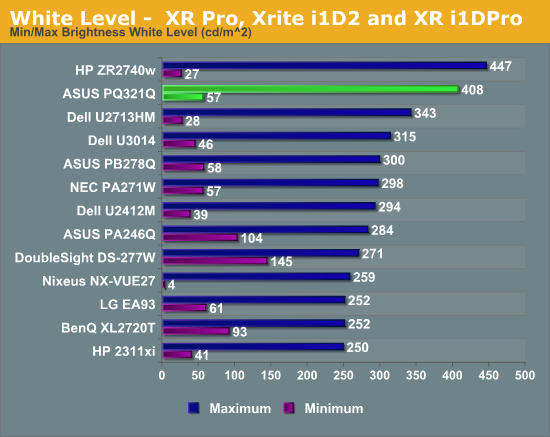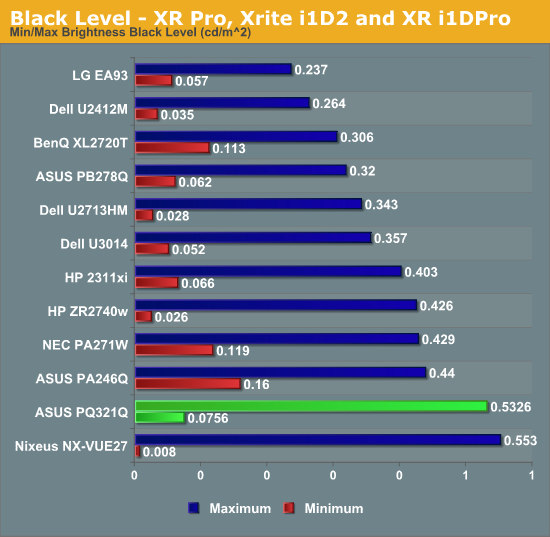ASUS PQ321Q UltraHD Monitor Review: Living with a 31.5-inch 4K Desktop Display
by Chris Heinonen on July 23, 2013 9:01 AM ESTSince the ASUS has a pair of HDMI inputs, but there is effectively no 4K HDMI content right now, the performance of the internal scaler is essential to know. To test it, I use an Oppo BDP-105 Blu-ray player and the Spears and Munsil HD Benchmark, Version 2. The Oppo has its own 4K scaler so I can easily compare the two and see how the ASUS performs.
First off, the ASUS is poor when it comes to video processing. Common film and video cadences of 3:2 and 2:2 are not properly picked up upon and deinterlaced correctly. The wedge patterns are full of artifacts and never lock on. With the scrolling text of video over film, the ASUS passed which was strange as it fails the wedges. It also does a poor job with diagonals, showing very little if any filtering on them, and producing lots of jaggies.
Spears and Munsil also has a 1080p scaling pattern to test 4K and higher resolution devices. Using the ASUS scaler compared to the Oppo it had a bit more ringing but they were pretty comparable. This becomes very important for watching films or playing video games, as you’ll need to send a 1080p signal to get a 60p frame rate. 24p films will be fine, but concerts, some TV shows and some documentaries are 60i and would then appear choppy if sent at 4K over HDMI.
Brightness and Contrast
In our preview of the PQ321Q, we looked at how it performed out of the box with the default settings. What we did see is that the PQ321Q can get really, really bright. Cranked up to the maximum I see 408 cd/m2 of light from it. That is plenty no matter how bright of an office environment you might work in. At the very bottom of the brightness setting you still get 57 cd/m2. That is low enough that if you are using it for print work or something else in a darkened room the brightness won’t overwhelm you.

The change to IGZO caused me to wonder how the black levels would behave on the ASUS. If energy flows far more freely, would that cause a slight bit of leakage to lead to a higher black level? Or would the overall current be scaled down so that the contrast ratio remains constant.
I’m not certain what the reason is, but the black level of the PQ321Q is a bit higher than I’d like to see. It is 0.756 cd/m2 at the lowest level and 0.5326 cd/m2 at the highest level. Even with the massive light output of the ASUS that is a bit high.

Because of this higher black level, we see Contrast Ratios of 755:1 and 766:1 on the ASUS PQ321Q. These are decent, middle-of-the-pack numbers. I really like to see 1,000:1 or higher, especially when we are being asked to spend $3,500 on a display. Without another IGZO display or 4K display to compare the ASUS to, I can’t be certain if one of those is the cause, or if it is the backlighting system, or something else entirely. I just think we could see improvements in the black level and contrast ratio here.











166 Comments
View All Comments
NLPsajeeth - Tuesday, July 23, 2013 - link
Great review.While dual HDMI 4k doesn't work at the moment, NVIDIA are working on hacks to their driver (pcper has a beta copy for testing) so you should see this functionality soon.
If NVIDIA actually supported 2x1 and 2x2 Surround with any monitor, they wouldn't have to resort to such hacks but apparently artificially crippling their Windows driver to preserve Quadro revenue is more important.
Tiled 4K displays are going to be more common with all the delays HDMI 2 is facing. 10-bit color is also going to be standard with all these displays. So I have to wonder how long they can keep crippling their windows driver and how scalable is having EDID whitelist for these types of monitors.
On the plus side, at least the GeForce Linux drivers aren't crippled like this.
Steveymoo - Tuesday, July 23, 2013 - link
Great, finally. I also find it irritating that tech built for disposible, none productive consumers is being given priority for improvements over professional desktop hardware (which would give tangible benefits to people doing actual work.)You mention the new tech uses a more responsive chemical composition, and I can't see a refresh rate in your spec list. Are we likely to ever see these screens run above 60hz? Probably not.
cheinonen - Tuesday, July 23, 2013 - link
Right now I'm not sure that DisplayPort can handle this resolution at refresh rates above 60 Hz. HDMI 2.0 should allow for up to 120 Hz at that resolution, at least if they follow the full Rec. 2020 UHD spec, but that keeps getting delayed.DanNeely - Tuesday, July 23, 2013 - link
Is HDMI2.0 4k@120hz a dual cable solution? I looked at what's written up in Wikipedia and it's listed as maxing out at 4k@60hz; the same limit as DP 1.2.cheinonen - Tuesday, July 23, 2013 - link
HDMI 2.0 isn't final or announced yet. Any specs that are out there for it are rumors right now. The UHD spec, Rec. 2020, calls for up to 120Hz at 8K resolutions. I don't think we'll see that, but I'd think we see 120Hz at 4K because you need at least 96 Hz to support high frame rate 3D, like The Hobbit, if that ever comes to the home.DanNeely - Tuesday, July 23, 2013 - link
4k@120hz would be nice; but even at only 24bit color that's a 24 gigabit datastream. Short of going stealth-dual cable by adding additional data lines I don't think the technology is here to do that at an affordable cost in the near future.madmilk - Tuesday, July 23, 2013 - link
Thunderbolt shows that it is possible to have 40Gbps in a DisplayPort socket. Certainly not cheap though. I don't see the active cables being a necessity though, so long as fiber is not required.sheh - Tuesday, July 23, 2013 - link
Would be nice if it supported 120Hz at least at 1920x1080. It certainly supports the bandwidth already.dishayu - Tuesday, July 23, 2013 - link
I think 31.5 inches is slightly too big and 30Hz WAY too low. Just like Chris says it's hard to go to a lower resolution display. I think, for me it is hard to give up the amazing IPS colors and 120Hz refresh rate. And I don't think there are any 27 inch 4K, 120Hz monitors in the pipeline for the next 5 years. (And we're not even talking affordle yet). Looks like i'm going to be stuck at 27 inch 1440p, 120Hz for some time to come.cheinonen - Tuesday, July 23, 2013 - link
The ASUS runs at 60Hz with either a DisplayPort 1.2 connection using MST (how I tested) or dual HDMI 1.4 outputs, which I don't have on my graphics card and couldn't test.